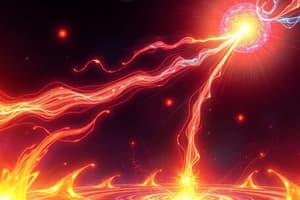Podcast
Questions and Answers
What is the formula for gravitational potential energy change near the Earth's surface?
What is the formula for gravitational potential energy change near the Earth's surface?
- ΔE p = mgΔh (correct)
- ΔE p = mg/s
- ΔE p = mgh
- ΔE p = 0.5mv^2
What does the elasticity/spring constant affect in the context of potential energy?
What does the elasticity/spring constant affect in the context of potential energy?
- Kinetic energy
- Thermal energy
- Elastic potential energy (correct)
- Gravitational potential energy
How is kinetic energy (E k) derived in relation to mass and speed?
How is kinetic energy (E k) derived in relation to mass and speed?
- E k = ma^2
- E k = 2ma
- E k = 0.5mv^2 (correct)
- E k = mv^2s
Which of the following reflects a decrease in gravitational potential energy?
Which of the following reflects a decrease in gravitational potential energy?
What causes the difference between the initial kinetic energy and the maximum gravitational potential energy of a ball that has stopped in mid-air?
What causes the difference between the initial kinetic energy and the maximum gravitational potential energy of a ball that has stopped in mid-air?
How is work done on a gas calculated when it is at constant pressure?
How is work done on a gas calculated when it is at constant pressure?
What is the relationship between force, distance, and work done?
What is the relationship between force, distance, and work done?
Which statement is true regarding mass and elastic potential energy?
Which statement is true regarding mass and elastic potential energy?
Which of the following formulas represents efficiency as a percentage?
Which of the following formulas represents efficiency as a percentage?
What is the formula for calculating kinetic energy of an object?
What is the formula for calculating kinetic energy of an object?
What happens to an object's gravitational potential energy when it does positive work?
What happens to an object's gravitational potential energy when it does positive work?
Which factor is NOT considered when calculating work done?
Which factor is NOT considered when calculating work done?
What is Newton’s Second Law commonly expressed as?
What is Newton’s Second Law commonly expressed as?
Why is the efficiency of a system never considered to be 100%?
Why is the efficiency of a system never considered to be 100%?
What does θ represent in the work done formula W = F s cos θ?
What does θ represent in the work done formula W = F s cos θ?
How can kinetic energy be transformed within a system?
How can kinetic energy be transformed within a system?
If an object is lifted vertically with a constant velocity, what must be true about the forces acting on it?
If an object is lifted vertically with a constant velocity, what must be true about the forces acting on it?
What equation represents the relationship between work done and change in potential energy?
What equation represents the relationship between work done and change in potential energy?
In the context of a simple pendulum, what is the potential energy at the maximum height of the swing?
In the context of a simple pendulum, what is the potential energy at the maximum height of the swing?
When calculating the maximum speed of a pendulum, which principle is primarily used?
When calculating the maximum speed of a pendulum, which principle is primarily used?
What is the correct calculation for the gravitational potential energy of a mass of 500g raised by a height of 10cm?
What is the correct calculation for the gravitational potential energy of a mass of 500g raised by a height of 10cm?
What formula is used to derive the maximum speed of the pendulum from its potential energy?
What formula is used to derive the maximum speed of the pendulum from its potential energy?
Why can air resistance be ignored in calculations involving the pendulum’s motion?
Why can air resistance be ignored in calculations involving the pendulum’s motion?
How is power defined in the context of energy transfer?
How is power defined in the context of energy transfer?
What is the formula used to calculate power based on work and time?
What is the formula used to calculate power based on work and time?
To calculate the energy transferred by an electrical appliance, what product should be used?
To calculate the energy transferred by an electrical appliance, what product should be used?
If a kettle requires 163800 J of energy and has a power rating of 1200 W, how long will it take to boil 0.5 kg of water?
If a kettle requires 163800 J of energy and has a power rating of 1200 W, how long will it take to boil 0.5 kg of water?
What is the kinetic energy gained by a 0.6 kg ball that accelerates to 12 m/s?
What is the kinetic energy gained by a 0.6 kg ball that accelerates to 12 m/s?
What force is generated by a car traveling at a constant velocity of 15 m/s against a frictional force of 200 N?
What force is generated by a car traveling at a constant velocity of 15 m/s against a frictional force of 200 N?
How is power calculated for a car traveling at constant velocity against a frictional force?
How is power calculated for a car traveling at constant velocity against a frictional force?
Which of the following is true about energy transfer in the context of electrical appliances?
Which of the following is true about energy transfer in the context of electrical appliances?
If the average power gained by an accelerating ball is 216 W, how much energy was transferred if the time taken was 0.2 s?
If the average power gained by an accelerating ball is 216 W, how much energy was transferred if the time taken was 0.2 s?
What does the principle of conservation of energy state?
What does the principle of conservation of energy state?
Which type of energy is dependent on an object's height above the ground?
Which type of energy is dependent on an object's height above the ground?
How is energy transferred when a spring is compressed?
How is energy transferred when a spring is compressed?
What happens to the kinetic energy of a ball thrown upwards as it rises?
What happens to the kinetic energy of a ball thrown upwards as it rises?
Which statement correctly describes internal energy?
Which statement correctly describes internal energy?
When an object is squashed, what form of energy is primarily stored?
When an object is squashed, what form of energy is primarily stored?
What result occurs when a ball reaches its highest point after being thrown?
What result occurs when a ball reaches its highest point after being thrown?
When thermal/internal energy is emitted by a radiator, through which form is it transmitted?
When thermal/internal energy is emitted by a radiator, through which form is it transmitted?
Flashcards
Conservation of Energy
Conservation of Energy
The total energy of a closed system remains constant.
Energy
Energy
The ability to do work.
Gravitational Potential Energy
Gravitational Potential Energy
Energy stored due to an object's position within a gravitational field.
Kinetic Energy
Kinetic Energy
Signup and view all the flashcards
Internal Energy
Internal Energy
Signup and view all the flashcards
Elastic Potential Energy
Elastic Potential Energy
Signup and view all the flashcards
Electrical Potential Energy
Electrical Potential Energy
Signup and view all the flashcards
Energy Conversion
Energy Conversion
Signup and view all the flashcards
Work Done
Work Done
Signup and view all the flashcards
Kinetic Energy (Ek)
Kinetic Energy (Ek)
Signup and view all the flashcards
Potential Energy (Ep)
Potential Energy (Ep)
Signup and view all the flashcards
Work
Work
Signup and view all the flashcards
Efficiency
Efficiency
Signup and view all the flashcards
Efficiency (Percentage)
Efficiency (Percentage)
Signup and view all the flashcards
Law of Conservation of Energy
Law of Conservation of Energy
Signup and view all the flashcards
Work-Energy Theorem
Work-Energy Theorem
Signup and view all the flashcards
Energy Conservation
Energy Conservation
Signup and view all the flashcards
Change in Gravitational Potential Energy
Change in Gravitational Potential Energy
Signup and view all the flashcards
Earth's Gravitational Field
Earth's Gravitational Field
Signup and view all the flashcards
Power
Power
Signup and view all the flashcards
Work-energy theorem (Gravitational Potential Energy)
Work-energy theorem (Gravitational Potential Energy)
Signup and view all the flashcards
Work done against gravity
Work done against gravity
Signup and view all the flashcards
Pendulum Speed & Energy
Pendulum Speed & Energy
Signup and view all the flashcards
Air Resistance
Air Resistance
Signup and view all the flashcards
Power = Force x Velocity
Power = Force x Velocity
Signup and view all the flashcards
Work Done by an Electrical Appliance
Work Done by an Electrical Appliance
Signup and view all the flashcards
Power as Energy Transfer Rate
Power as Energy Transfer Rate
Signup and view all the flashcards
Energy Transferred
Energy Transferred
Signup and view all the flashcards
Study Notes
Work, Energy, and Power
-
Energy Conservation: Energy cannot be created or destroyed, only transferred between forms. The total energy in a closed system stays constant.
-
Energy Forms: Energy exists in various forms, including:
- Gravitational potential energy (dependent on height and mass)
- Kinetic energy (dependent on mass and velocity)
- Internal energy (sum of kinetic and potential energies of particles)
- Elastic potential energy (stored in stretched or compressed objects)
- Electrical potential energy (dependent on a charge's position in an electric field)
-
Energy Transfer: Energy transfers occur when:
- Work is done (e.g., squashing an object converts kinetic to elastic potential energy)
- Energy is absorbed or emitted as electromagnetic radiation (e.g., infrared radiation)
-
Example - Ball Toss: When a ball is thrown upwards, kinetic energy is initially high, converting to gravitational potential energy as it rises, and back to kinetic energy as it falls.
Work
-
Definition: Work (W) is the force causing motion multiplied by the distance traveled in the direction of the motion.
-
Formula: W = Fs cos θ, where:
- F is the force
- s is the distance traveled
- θ is the angle between the force and the direction of motion
Efficiency
-
Definition: Efficiency measures how effectively a system transfers energy. It is the ratio of the useful output power to the total input power.
-
Formula: Efficiency = (useful output power / input power) x 100%
-
Limit: Efficiency is always less than 100% because some energy is always lost (e.g., to friction).
Kinetic Energy
-
Definition: Kinetic energy (Ek) is the energy an object possesses due to its motion.
-
Formula: Ek = 1/2mv², where:
- m is the mass of the object
- v is the velocity of the object
Potential Energy (Gravitational)
-
Definition: Gravitational potential energy (Ep) is the energy an object possesses due to its position in a gravitational field.
-
Formula (near Earth's surface): ΔEp = mgΔh, where:
- m is the mass of the object
- g is the acceleration due to gravity
- Δh is the change in height
Power
-
Definition: Power (P) is the rate of energy transfer (or work done).
-
Formula: P = W/t (where W is work done and t is time)
- Alternatively: P = Fv (where F is force and v is velocity)
Studying That Suits You
Use AI to generate personalized quizzes and flashcards to suit your learning preferences.




